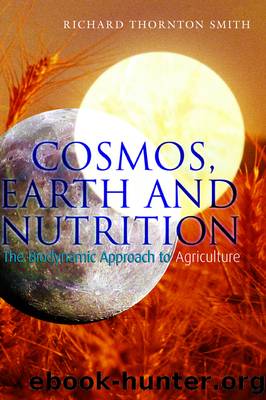Cosmos, Earth and Nutrition by Richard Thornton Smith

Author:Richard Thornton Smith
Language: eng
Format: epub
Publisher: Rudolf Steiner Press
Published: 2012-11-15T00:00:00+00:00
Fig. 7.1 Lettuce, leek and onion seed crops in a polytunnel at Bingenheim, Germany (Peter Brinch)
Fig. 7.2 Carrot seed crop at Dottenfelderhof, Germany (Peter Brinch)
The selection procedure adopted by breeders thus identifies elite seed, from which plant breeding will continue, and standard seed, which is the quality sold to the market. In reality todayâs elite seed will very likely become tomorrowâs standard seed following its multiplication. Elite seed results from rigorous selection. It may only be collected from 10â15% of the plantsâpositive selection. On the other hand, negative selection may be adopted. Here, up to 20% of plants which exhibit weakness, disease, poor shape or which go to seed too early are âroguedâ (pulled out or cut) to leave a remaining superior crop for seed production.
While elite seed will normally be harvested from chosen whole plants, more sophisticated selection may be carried out. For further selection and research this may involve taking the first seed heads to develop (known as the âKingâs Headâ) or selecting seed according to its position on the stalkâcereal grains for example. The higher germination rate of such seed points to its superior quality and vitality. Elite seed is often subject to what is known as progeny testing to ensure that desired traits emerge consistently in subsequent generations.23
Biodynamic plant breeding has developed mainly in Germany, and in recent years has taken a new direction under the guidance of Dorian Schmidt. This approach is based on developing faculties of observation in the field of natureâs formative forces. Trained observation of subtle energies in the plant kingdom has helped to bring an understanding of otherwise hidden attributes present in our food plants. These show themselves to the trained eye as colours, as lightness or darkness, and as movement and gestures. The qualities arising from such observations are used to determine whether plants carry suitable inner qualities of nutritional value to be used for further breeding. In this way, a number of food plants have been identified as having qualities of healing, whereas certain varietiesâmostly modern onesâhave been experienced as unsuitable for human nutrition. Perceptual research does not, of course, rule out the need for suitable physically based breeding methods to be used, but in aiming away from a purely materialistic direction it offers a new basis for selection of future food plants.24
Post-harvest procedures
After seeds have been collected they will require to be thoroughly dried (Fig. 7.3). Seeds from moist fruits such as cucumbers and tomatoes need to be fermented in water to remove gelatinous coating. They are then washed and dried, preferably in the sun, without delay. After drying seeds, cleaning and grading takes place according to size or other characteristics. This ranges from the use of sieves and sorting on trays, to winnowing by the wind or a fan, or the use of special machines (Fig. 7.4). After grading, seeds should be stored unharmed until required for sowing. Adequate space must be allocated for this, and the professional seed producer will often use a cupboard with multiple shelves kept at constant temperature and humidity prior to packing for sale.
Download
This site does not store any files on its server. We only index and link to content provided by other sites. Please contact the content providers to delete copyright contents if any and email us, we'll remove relevant links or contents immediately.
| Automotive | Engineering |
| Transportation |
Whiskies Galore by Ian Buxton(40294)
Introduction to Aircraft Design (Cambridge Aerospace Series) by John P. Fielding(32329)
Small Unmanned Fixed-wing Aircraft Design by Andrew J. Keane Andras Sobester James P. Scanlan & András Sóbester & James P. Scanlan(32135)
Craft Beer for the Homebrewer by Michael Agnew(17439)
Turbulence by E. J. Noyes(7031)
The Complete Stick Figure Physics Tutorials by Allen Sarah(6631)
Kaplan MCAT General Chemistry Review by Kaplan(6044)
The Thirst by Nesbo Jo(5778)
Bad Blood by John Carreyrou(5761)
Learning SQL by Alan Beaulieu(5399)
Weapons of Math Destruction by Cathy O'Neil(5029)
Man-made Catastrophes and Risk Information Concealment by Dmitry Chernov & Didier Sornette(4728)
iGen by Jean M. Twenge(4693)
Digital Minimalism by Cal Newport;(4510)
Life 3.0: Being Human in the Age of Artificial Intelligence by Tegmark Max(4492)
Audition by Ryu Murakami(4091)
1,001 ASVAB Practice Questions For Dummies by Powers Rod(4034)
Electronic Devices & Circuits by Jacob Millman & Christos C. Halkias(4019)
Pale Blue Dot by Carl Sagan(3995)
